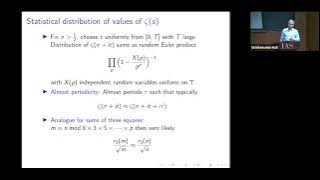
Interesting Facts About the Last Digits of Prime Numbers
This video explains some interesting facts about the last digits of prime numbers.
From playlist Mathematics General Interest

Why Are There Infinitely Many Prime Numbers?
Here's why there are infinitely many prime numbers!
From playlist Summer of Math Exposition Youtube Videos

https://sites.google.com/site/teachshsat/ SHSAT and prime numbers
From playlist SHSAT - 8th Grade Samples

Prealgebra 3.02b - Prime Numbers
An introduction to prime numbers. What they are and some essential concepts.
From playlist Prealgebra Chapter 3 (Complete chapter)

MegaFavNumbers: Plus One Primes, 154,641,337, and 62,784,382,823
My entry in the #MegaFavNumbers series looks at a particularly striking example of a very specific family of primes -- and how it connects to what digits can be the final digit of primes in different bases.
From playlist MegaFavNumbers

Introduction to prime numbers for GCSE 9-1 maths!
From playlist Prime Numbers, HCF and LCM - GCSE 9-1 Maths

Prealgebra 3.02d - Prime and Composite Numbers
The distinction between prime and composite numbers, and some simple examples.
From playlist Prealgebra Chapter 3 (Complete chapter)

Sieve methods: what are they, and what are they good for? - James Maynard
Analysis Seminar Topic: Sieve methods: what are they, and what are they good for? Speaker: James Maynard Affiliation: Member, School of Mathematics Date: December 13, 2017 For more videos, please visit http://video.ias.edu
From playlist Mathematics

Worldwide Calculus: Distance Traveled in Space and Arc Length
Lecture on 'Distance Traveled in Space and Arc Length' from 'Worldwide Integral Calculus' and 'Worldwide AP Calculus'. For more lecture videos and $10 digital textbooks, visit www.centerofmath.org.
From playlist Applications of Integration

Worldwide Calculus: Multi-Component Functions of a Single Variable
Lecture on 'Multi-Component Functions of a Single Variable' from 'Worldwide Multivariable Calculus'. For more lecture videos and $10 digital textbooks, visit www.centerofmath.org.
From playlist Worldwide Multivariable Calculus

Worldwide Calculus: Parameterized Curves and Motion
Lecture on 'Parameterized Curves and Motion' from 'Worldwide Differential Calculus' and 'Worldwide AP Calculus'. For more lecture videos and $10 digital textbooks, visit www.centerofmath.org.
From playlist Anti-differentiation & Differential Equations

Guy Rothblum : Privacy and Security via Randomized Methods - 3
Recording during the thematic meeting: «Nexus of Information and Computation Theories » theJanuary 27, 2016 at the Centre International de Rencontres Mathématiques (Marseille, France) Filmmaker: Guillaume Hennenfent
From playlist Nexus Trimester - 2016 -Tutorial Week at CIRM

Part II: Differential Equations, Lec 7: Laplace Transforms
Part II: Differential Equations, Lecture 7: Laplace Transforms Instructor: Herbert Gross View the complete course: http://ocw.mit.edu/RES18-008F11 License: Creative Commons BY-NC-SA More information at http://ocw.mit.edu/terms More courses at http://ocw.mit.edu
From playlist MIT Calculus Revisited: Calculus of Complex Variables

Lec 9 | MIT 6.451 Principles of Digital Communication II
Introduction to Finite Fields View the complete course: http://ocw.mit.edu/6-451S05 License: Creative Commons BY-NC-SA More information at http://ocw.mit.edu/terms More courses at http://ocw.mit.edu
From playlist MIT 6.451 Principles of Digital Communication II

The distribution of values of zeta and L-functions
50 Years of Number Theory and Random Matrix Theory Conference Topic: The distribution of values of zeta and L-functions Speaker: Kannan Soundararajan Affiliation: Stanford University Date: June 21, 2022 I will survey recent progress on understanding the value distribution of zeta and L-f
From playlist Mathematics

Functional Analysis Lecture 04 2014 01 30 Dual L^p spaces
Isometry between Dual L^p and L^p’; key lemma
From playlist Course 9: Basic Functional and Harmonic Analysis

Beginners lesson on finding prime numbers
This is an introduction to finding prime numbers. This method uses the ideas of the Sieve of Eratosthenes. https://www.etsy.com/listing/1037552189/wooden-large-platonic-solids-geometry
From playlist Math formulas, proofs, ideas explained

MIT 3.60 | Lec 16a: Symmetry, Structure, Tensor Properties of Materials
Part 1: Tensors (cont.) View the complete course at: http://ocw.mit.edu/3-60F05 License: Creative Commons BY-NC-SA More information at http://ocw.mit.edu/terms More courses at http://ocw.mit.edu
From playlist MIT 3.60 Symmetry, Structure & Tensor Properties of Material

